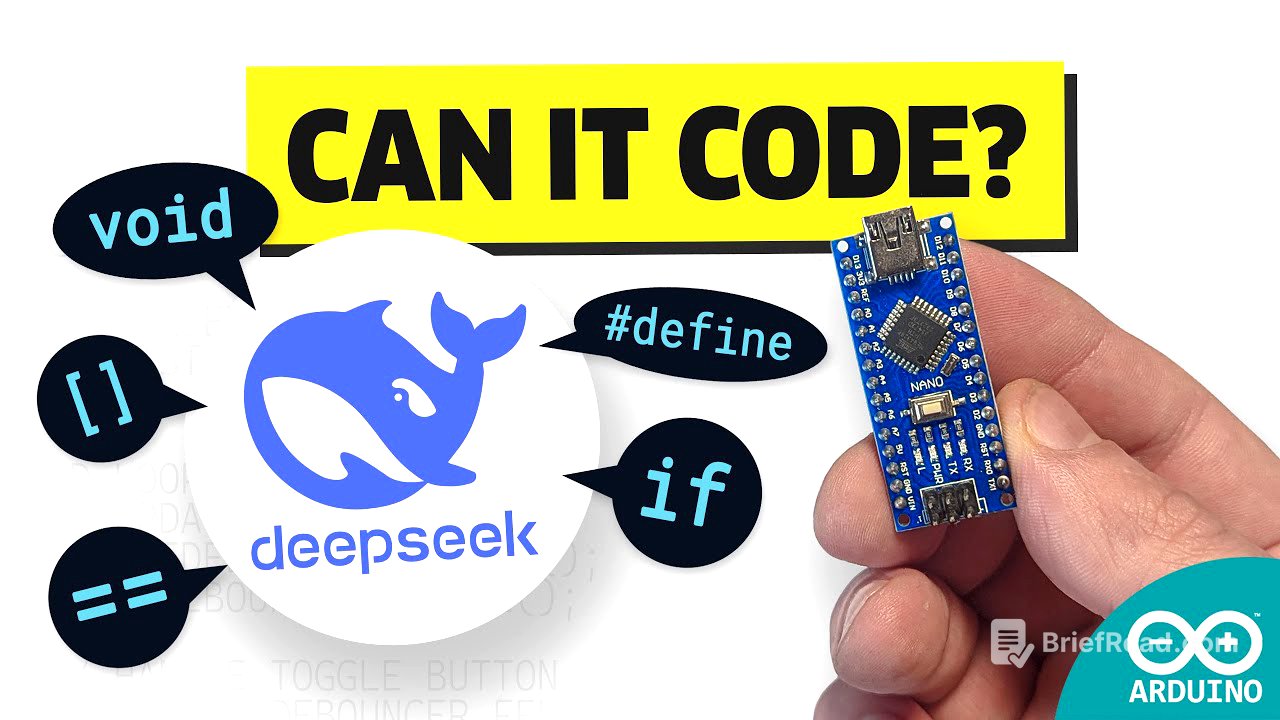TLDR;
This video tests DeepThink's ability to write Arduino code for a simple project involving a NeoPixel strip, two buttons, and non-volatile memory. The video compares DeepThink's performance to other AI chat applications tested in a previous video. DeepThink initially struggles with debouncing the buttons, but after being provided with the error, it successfully fixes the code. The video concludes with a discussion of DeepThink's strengths and weaknesses, and its potential impact on the future of software development.
- DeepThink is a new AI chat application that is being tested for its ability to write Arduino code.
- DeepThink initially struggles with debouncing the buttons, but after being provided with the error, it successfully fixes the code.
- The video concludes with a discussion of DeepThink's strengths and weaknesses, and its potential impact on the future of software development.
Lookback [0:00]
The video begins with a recap of a previous video where five different AI chat applications were tested for their ability to write Arduino code. Claude, one of the applications, performed well but did not produce a completely accurate solution. This video aims to test DeepThink, a new AI chat application, under the same conditions as the previous test.
Test Conditions [0:59]
The test conditions are identical to the previous video. The prompt involves creating an Arduino application that controls a NeoPixel strip with two buttons. One button toggles the lights on and off, while the other cycles through the colors of the rainbow. The application should also store the state of the lights and the current color in non-volatile memory. The AI is given one opportunity to fix any errors in its code.
The Prompt [2:03]
The prompt for the AI is as follows: "I need help making an Arduino application that does the following things: We have an Arduino Nano and connected to pin 2 is a string of 186 NeoPixel lights. There's a button connected to pin 6. When it's pressed, it should toggle whether or not the lights are on. There is another button connected to pin 10. When this is pressed, the colors should cycle through the colors of the rainbow, moving to the next color each time it is pressed. When it reaches Violet at the end of the cycle, it should return to Red. The state of whether the lights are on and off and the color that they are currently set to should be stored in non-volatile memory. When the application turns off, the previous state should be reloaded. Use serial print lines to print on and off when the lights are turned on and off, and print the name and the value of the color when it changes."
DeepThinking [4:20]
DeepThink begins by analyzing the prompt and breaking down each requirement step by step. It discusses the hardware setup, button configuration, debouncing, color cycling, non-volatile memory storage, and serial communication. DeepThink demonstrates its ability to reason through the problem and consider different approaches to each requirement.
Code Analysis [17:32]
DeepThink generates a code solution that includes the necessary libraries, constants, variables, and functions. The code is analyzed in detail, highlighting the use of the NeoPixel library, the EEPROM library, and the debouncing technique. The video points out that DeepThink's code includes a potential error in the debouncing logic.
Test 1 [21:12]
The generated code is uploaded to the Arduino Nano. The initial test reveals that the code does not work as expected. The buttons do not trigger any actions, and there are no serial prints.
Self Debugging [21:32]
The video explains that the problem lies in the debouncing logic. The AI is then provided with a description of the error: "When the application starts up for the first time, the serial prints both in order to show the equivalent state, but when I press either button, nothing happens."
Test 2 [25:28]
DeepThink generates a revised code solution that includes separate debouncing states for each button. The code is uploaded to the Arduino Nano, but the problem persists.
Identifying Bugs [25:46]
The video identifies the bug in the debouncing logic. The AI is setting the debounce timer to the current time, but then immediately checking if the time difference is greater than the debounce delay. This results in the debounce logic never being triggered.
Self Debugging 2 [30:27]
The video demonstrates how to fix the debouncing logic by removing the unnecessary time comparison. The revised code is uploaded to the Arduino Nano, and the buttons now function correctly.
Test 3 [31:48]
The video tests the functionality of the code. The lights toggle on and off, the colors cycle through the rainbow, and the state is stored in non-volatile memory. The code is working as expected.
Thoughts [32:17]
The video concludes with a discussion of DeepThink's performance. The AI was able to generate a code solution that was close to working, but it required significant handholding to fix the debouncing issue. The video suggests that DeepThink's tendency to overcomplicate solutions may be a common issue with AI chat applications. Despite its flaws, DeepThink is still a significant improvement over previous AI chat applications, and it has the potential to revolutionize software development.









